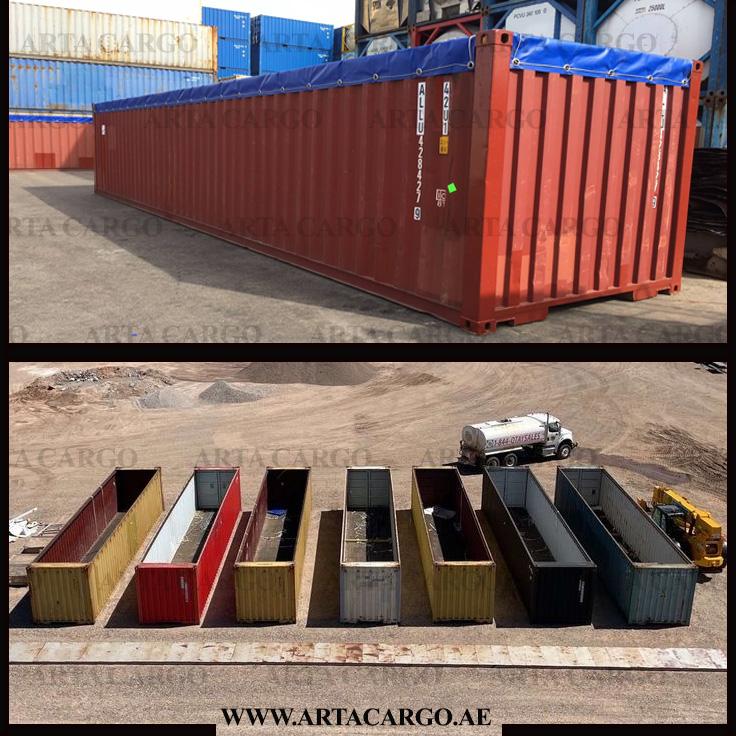What is a container?
A container is a reusable, sturdy metal box that can be sealed and used to hold products for transit by truck, train, or ship. This definition of a container pertains to logistics and transportation. Of course, it is important to note that the container may occasionally be utilized for other purposes, such as a warehouse.
Different types of containers exist based on the kind of items they carry, the unique services needed, and general characteristics like dimensions and structure.
General Purpose Container or GP Container:
The size of the container's interior dimensions is crucial to us when loading it, and we must always keep in mind that loading should be done so that the door closes smoothly. You can ask our knowledgeable colleagues at Arta Cargo Company any questions you may have regarding containers and types of containers, including expert advice on selecting the type of container based on the kind and weight of goods and cargo within.
Internal dimensions of the 20ft and 40ft containers:
|
Dimensions of 20’ Container DC / GP / HD |
|
|
Internal Length |
590 CM |
|
Internal Width |
235 CM |
|
Internal Height |
239 CM |
|
Cubic Capacity |
33 M3 |
|
Tare Weight |
2300 KG |
|
Dimensions of 40’ Container DC / GP |
|
|
Internal Length |
1200 CM |
|
Internal Width |
235 CM |
|
Internal Height |
239 CM |
|
Cubic Capacity |
67 M3 |
|
Tare Weight |
3750 KG |
Here we are going to add two more kinds of containers to this group:
What is 20’ Container HD (Heavy Duty)
All details are same as 20’ Container DC / GP but payload capacity is more.
Maximum payload of 20’ Container DC / GP depends on container health condition can be vary between 22 up to 25 tons but in 20’ Container HD can be loaded up to 27 or 29 tons.
What is 40’ Container HC (High Cube)
All details are same as 40’ Container DC / GP but Internal Height is more.
What is the height of a 40ft high cube container? It is 280 CM.
Refrigerated Container or Reefer Container:
Certain containers, used for goods like fish, shrimp, vegetables, flowers, chocolate, medicine, fruits, etc. that must be transported under temperature and humidity and constant environmental conditions, have the ability to maintain a constant temperature and humidity during the transportation route because of the equipment designed into them.
The product must be cooled to the appropriate temperature before loading because refrigerated containers are not meant to raise or lower the temperature; rather, they are meant to maintain a consistent environment.
Open Top Container:
This container's appearance is defined by its name. This container is ideal for carrying items that are taller and will protrude from the roof of the container because it is roofless.
Following the loading of the cargo into the container, the roof is covered with a tarpaulin tent that may be sealed and is attached to the body of the container using hooks from the sides. Open-top containers are used to transport not only high-height items but also non-high items whose weight and size prevent them from being loaded through the container's side doors.

Flat Rack Container or FR container:
It is reported that flat rack containers have no side walls or roof, and only two movable walls at either end that may be folded to transform the container into a flat plate as necessary.
These containers come in two sizes: 20 feet and 40 feet, and are used to transport big and bulky items like construction equipment or machinery.

ISO Tank container:
The greatest method to describe this container is with an image of an iso tank. For transporting liquids, gasses, and chemicals, tank containers are utilized.

In terms of ownership, containers are divided into two groups:
Containers for COC and SOC
COC containers:
It means that the owner of these containers is the shipping line and it stands for Carrie Owned container.
SOC containers:
It indicates that the sender, the recipient, or a different third party from the shipping company is the owner of the container.
Cargo Out of Gauge (OOG):
It is referred to as a product whose size prevents it from being placed into 40-foot containers.
In Gauge Cargo:
A product is referred to be in gauge cargo if its dimensions are less than those of an open top container or a flat rack container inside.
You, dear consumers, can count on the knowledgeable staff to offer you the greatest services at the most affordable costs.
The purpose of this article was to provide a brief definition of a container and introduce you to Arta Cargo Company, With its professional team and experienced staff located in various ports, the company aims to offer sea transportation and container services to its valued customers at the most affordable price in the shortest amount of time.
Please get in touch with our colleagues if you have any questions or need more information regarding sea or container shipping.


